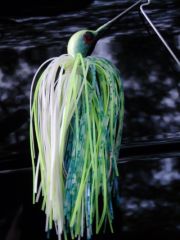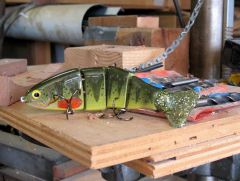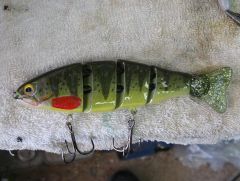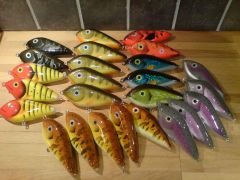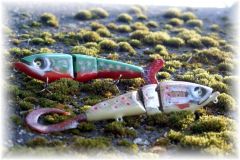-
Posts
14,726 -
Joined
-
Last visited
-
Days Won
364
Content Type
Profiles
Articles
TU Classifieds
Glossary
Website Links
Forums
Gallery
Store
Everything posted by mark poulson
-
Dave, You're right, a drying box would be more cost efficient and would allow drying larger quantities. I was suggesting the microwave just for testing to see what happens to a small sample when it's dried, to find out if the wood is actually usable for lures, before making an investment of time, energy, and money on a larger scale drying system.
-
But don't you miss the numb hands, aching shoulders, stiff and sore back, stiff and sore knees, and blowing your sinuses out every night? Man, if I had known this is what growing up is all about, I never would have done it! Where is that damn Tinkerbell when you need her??
-

Experienced airbrusher with questions....
mark poulson replied to 68KingFisher's topic in Hard Baits
Great to have another experienced solvent based painter onboard! No offense, KCDano. -
Gunnie, What did it do?
-

-Createx Paint Colors Trout Pattern?-
mark poulson replied to steelheadstalkers's topic in Hard Baits
Snax, Do I remember right that you said Wicked Colors don't need to be heat set, or was that just another hallucination? -
I would cut it up into rectangular blocks the size you need for lures, avoiding the heart core of the tree. The heart core gives the wood an axis to twist around. Then do some test dryings, one sample piece at a time, in a microwave, starting with short bursts, like 30 seconds, and increasing until you find you're cracking the wood. If you can, put some triangular strips of another, already dry wood under the blocks to raise them up off the glass tray, so moisture can escape evenly. The triangular shape is to keep the contact from the test block to the strips as small a possible. Then back off to the last time increment before the cracking, and do a final test drying of one of the samples. After the drying run, cut the blank open and check the moisture content of the center. If it's at that 6 percent, or something in that range, you'll be good to go. You should also be able to see if the wood is going to shrink or cup, which can be a problem for lure making, when it's been microwaved. Lots of hardwoods also have a high oil content, and that can be a problem in painting and finishing. The microwave test should make any oils come up to the surface, so you can see if that will be a problem. Good luck, and let us know what you find out.
-
I wouldn't know about mixing large amounts of epoxy, but I use a wire for mixing my batches, too. I only coat 4 baits max. at a time, and then mix another batch. My wheel holds eight baits at two different levels, so I put on the inner set of four, coat them, and then put on four more on the outside, and coat them. I mix my Etex and Nu Lustre in salsa cups, with a paper clip. I leave the bend in the paper clip, straighten out the middle so it's longer, and use the smaller end for the mixing. Afterward I tap it hard against the side of the cup, and any epoxy on it comes off. Mostly. I mix, at the most, 6ccs of epoxy, and I mix it by hand for a minute at the most. Then I let it sit for a couple of minutes to let any air bubbles rise, and to let any unmixed epoxy get absorbed and mixed. If I need to, I blow on the epoxy and roll it around in the cup to get most of the bubbles out. Brushing it onto the bait usually takes care of the rest. In fact, I find that, if I'm not careful, brushing, even with a small,fine artists bristle brush, will make some fine bubbles by itself, and I check the baits after I coat them to be sure those "scum" bubbles are gone. If they remain, I rebrush those areas, making sure they disappear. I do check on the baits after half an hour on the drying wheel, just to be sure I catch any sags, build-ups, bare spots, or bubbles that might have developed. One problem I've run into is air bubbles that come out from under the stick-on eyes. I found that they are much more likely if I hit the bait with the hair dryer after it's coated, so I stopped doing that, unless it's really cold and won't brush out right. Fatfingers, you'll a trouble maker. Husky, have you tried Minwax Wood Hardener, or the other hardener Snax prefers, for sealing baits? It's designed to penetrate, and it does, really well. I do very few wood baits now, since I made the switch to PVC, but I still like pine for big surface gliders, like the Lunker Punker. You have to let it air dry for at least a day, to be sure all the solvent is gone, and it's best to hit it with a hair dryer after that, to be sure. If there's trapped solvent, it'll bubble out under the heat of the dryer, especially from any end grain. Better to have it bubble before any paint goes on. Once the bubble come out, let it sit another day and check it again with the dryer. I did a test, and, once I'd sealed a test piece of wood (pine), I let it dry, and then weighed it on my Weight Watchers scale, which measures in grams. Then I soaked it in water overnight, and reweighed it. The weight was exactly the same, to the gram, so I know it didn't absorb enough water to matter, or to ruin a bait in case the top coat failed. The hardener is readily available at Home Depot, and isn't that expensive. Plus it goes a long way. I predrill all my hardware and ballast holes, even if I don't wind up using all of them. That way I know the hardener has penetrated everywhere water might get. I start out soaking the bait pieces for 10 minutes, but I'll soak it longer if I see it's still chasing air out by the bubbles that come out of the end grain. I use a glass pickle bottle to soak them in. It has ended the dreaded "delamination due to water intrusion" problem for me.
-
-
That settles it! I nominate JR Hopkins for King!!!!! And as is typical with his genius, the "periscope" line tie, to get the line to pull lower without making a hole in the test tank, is brilliant. I was just sitting here trying to figure out how he got the lures down through it....
-
-
-
-
-
-
-
If it's still clear, with just a lump of goop in the bottom of the jar from undisolved plastic cups, I'd decant it by pouring it off slowly without letting the goop get mixed up in it, so all I had was the clear acetone. Then I'd try it with the propionate and see if it works. Even though it may have some plastic disolved in it, it's probably the same plastic that's in propionate, or something similar, and shouldn't mess up the final sealer. I'd do a test with a small amount of the tainted acetone and a few propionate pellets, and see if it works. Otherwise, if it's discolored and can't be reused, it's considered a hazardous material, like oil based paints, and you'll have to check with your local govt., maybe your fire dept., to find out how to dispose of it. You might also ask a local paint store.
-
You just proved the old saying, "Action catches the fish, paintjob catches the fisherman."
-
-
-
-
Do a search here for propionate. Palmetto Bass sells it, in the classifieds.
-
That's great! Nothing like catching fish on something you made yourself. Congrats.
-
robalo01, I guess the fool proof thing to do is to use Propionate. Someone on this site sells it.
-
In cold weather, up to 30 minutes. Then I hit it with a hair dryer to get it spreadable again once it starts to stiffen up. I have about an hour of decent working time, because, I think, the hair dryer speeds up the set of the epoxy, even though the air is cold. In warmer weather, I usually let it sit for 5 at the max. If I've mixed it really thoroughly, it has air bubbles, and by the time I finish blowing on it, and shifting it in the mixing cup so that the bubbles pop, it's ready. It has about a 45 minute working time, no problem, where it is still easy to brush on. After that, I can still brush out sags for a while and it will flow out again, but it's harder to apply evenly with a brush. The warmer air temps seem to accelerate the setting time, even without the hair dryer. I usually mix up enough to do four big baits at the max., about 2.5 or 3 ccs. If I'm doing more, I load those four on the inner part of my wheel, coat them, and let them turn while I'm mixing up another batch. I mix in the same, uncleaned mixing cup, and let it sit while I turnoff the wheel and mount the rest of the lures on the outer part of the wheel. Then I coat the new ones. I used to do this with Etex. Now I do it with Nu Lustre 55. Works the same.



